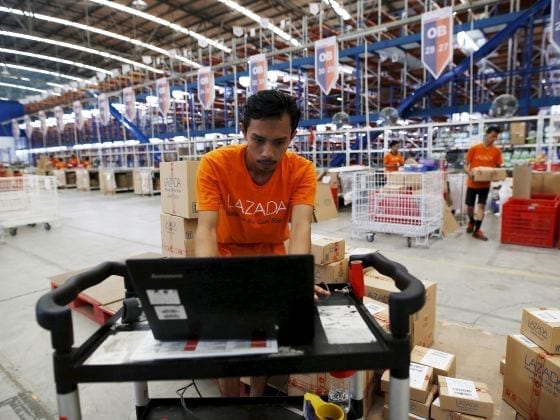
Southeast Asia is on the verge of a logistics “boom” thanks to e-commerce, but will require huge investment in cities and last-mile networks to cope, says Pierre Poignant, the man behind the systems that keep Alibaba-owned Lazada moving.
Mr Poignant, chief operating officer, said the Singapore-based marketplace, for its part, would continue to bet on delivery and other partnerships as demand grows. It already works with more than 100 companies in delivery and cross-border logistics, from Ninjavan in Singapore to ride-hailing start-up Go-Jek in Jakarta.
But it will expand its footprint to cut costs and improve services, with smaller local hubs closer to customers, as well as a major warehouse it can use in Malaysia for goods that move less often. Lazada, with 130,000 merchants on its platform, has 14 warehouses and over 2 million square feet of space — and plans to open another five to six warehouses next year. It also has 130 smaller distribution centres.
“Logistics in Southeast Asia is going to look very different from the rest of the world. It is hard to believe one player can do everything,” Mr Poignant said in an interview.
“The distance from Aceh to Papua [in Indonesia] is bigger than the distance from Miami to Seattle. People don’t realise.”
Already the world’s fourth-largest internet market, Southeast Asia is expanding at a rate of almost 4 million users a month, making it the fastest-growing e-commerce market globally, according to a 2016 report co-authored by Google.
But while there are key growth engines — a young population of active mobile users and a patchy local retail network — there are also major challenges, as companies like Lazada try to conquer a region made up of thousands of islands, with poor roads and traffic-clogged cities.
Some regions have no formal system for home addresses, Mr Poignant said, complicating deliveries, returns and even payment — more than half of transactions are still settled in cash.
That leads to experiments, combining online purchases with offline pick-up in malls, as in Singapore — or in Indonesia, where Lazada handles a bulk of the last-mile delivery itself, using three-wheeled electric vehicles for bigger parcels. Cars and vans are too slow in traffic, Mr Poignant said.
Taking the lead
Amazon and others, including local players, have not failed to notice the region’s potential: Amazon is using Singapore as its beachhead, while China’s second largest e-commerce company JD.com is making Thailand its point of departure, partnering with the country’s largest retailer, Central Group.
But Mr Poignant argues Lazada’s experience is hard to beat.
“When it comes to logistics we are developing a distinct competitive advantage. We are the only ones to have this open network approach — combining our own infrastructure and partners,” Mr Poignant said.
“Setting up a logistics network is a complex, long process.”
Critical to keeping the advantage is also data, and Lazada is linking up with fast-moving goods producers like Unilever, to turn knowledge into target sales.
Alibaba bought into Lazada last year in an effort to seek growth outside China. The $1-billion deal in April 2016 was Alibaba’s largest overseas deal and it raised its stake to over 80% this year.
Last November, Lazada bought Singapore online grocer Redmart, a purchase that it hopes will help it crack cold storage and expand groceries into the rest of the region, though there is no concrete plan yet, Mr Poignant said.
“One of the reasons why we acquired RedMart is that groceries is a very specific set of skills that you need to develop,” Mr Poignant said. “We have the ambition to develop this category across the region.”

